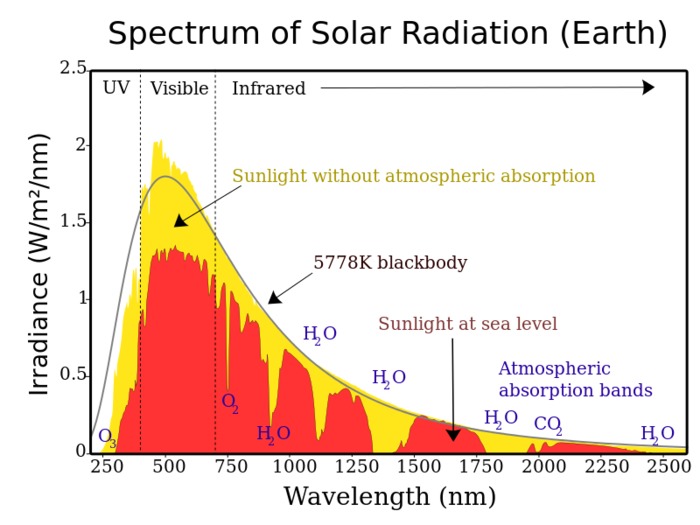I understand the phenomenon of rayleigh scattering. from this knowledge it seems logical to me that the sky turns red in the evening. But still this does not explain to me why more transition colors do not become visible towards the evening. If the light travels a longer distance through the atmosphere, the green should first become visible when the blue light is filtered out. This is because green has a shorter wavelength than red and would therefore undergo rayleigh scattering more quickly.





Answer
Dear Pieter,
To fully answer your question, we need to talk about physics, physiology, and psychology.
~
Your question assumes that the sky never changes from blue to green at night, but that’s not entirely true.
If you look above the horizon in the direction N or S (so not in the direction of the setting sun in the W) you will sometimes see a green zone there in the evening. It’s pale green and only a narrow region, but it’s there. It is easier to see when there are low clouds (like in my photo): by blocking part of the gradual transition (which you can also do with your hands if there are no clouds), you can see the transition from blue more clearly to green.
In the Dutch language area, we have access to a veritable treasure trove of these kinds of observations physical explanation (although not completely error-free): part 1 of “The physics of the free field” by Marcel Minnaert (fully online). Under the section “Light and color of the sky”, Minnaert indeed discusses the perception of green sky. See this link, then scroll down to paragraph 178: “When is the distant sky orange? When green?” The color is created by an interplay between scattering and absorption (attenuation).
A first explanation for the apparent absence of green in the sky is therefore psychological: we ‘know’ that the sky is blue (or orange-red at sunset). That is why we only recognize this green as such when someone points it out to us, or when we actively look for it.
~
This does not alter the fact that there is indeed little green and that the green is not ‘pure’ green. For the sake of clarity, I will add an explanation here.
We start again with the physics. Based solely on the informal explanation of Rayleigh scattering, one would expect that there is some kind of peak in the spectrum that reaches us and that that peak gradually shifts from blue to red as we see the sun lower on the horizon (longer optically). path, so more scattering of increasingly longer wavelengths). Based on that, you would expect the sky to get all the colors of the rainbow between blue and red. This is not what we see, hence your question.
To begin with, the spectrum of incident sunlight is a broad spectrum (see Figure 1). All wavelengths are slightly scattered. When there is a lot of cloud or dust in the sky, Mie scattering, which is not wavelength dependent, dominates and the sky turns white or gray. In a clear, dry sky, Rayleigh scattering dominates and, although it is strongly wavelength-dependent, the spectrum of the diffuse sunlight is not really sharply peaked under any circumstances. With a longer light path (when the sun is lower on the horizon), not only does the contribution of the scattering change, but the absorption also increases, so that the spectrum as a whole becomes lower (less intensity). The net effect is that green hardly gets through.
All this also has to do with the functioning of our eyes (physiology). We have three types of cone cells, each of which is sensitive to a part of the spectrum that is visible to us. See Figure 2 for the overlapping regions in which human photoreceptors are sensitive. (The maxima of the peaks are indicated as high in the figure, but in reality it is not so. The cells are not equally sensitive, but there are also not the same number of them and, moreover, the signals are processed in our brains. The sensitivity per type of cell does not say everything.) We can see colors because the different cells fire in a different ratio.
Although the maximum is at blue/green, diffuse sunlight during the day also contains shorter wavelengths (violet) and longer wavelengths (yellow/orange/red). We see this spectrum as sky blue. This suddenly gives you (part of) the answer to a related question: why don’t we see the sky as violet during the day? 🙂 See also this link and this link, both of which can also provide insight into the “why so little green?” question.
Perhaps another nice thing to know: the fact that we still see the sky above us as blue during and after sunset is because the light then travels a longer distance through the ozone layer, which has longer wavelengths (red end of the spectrum). ) absorbs. The effect of this is very clear in simulations.
If you want to know much more about it, from a source more recent than the book by Marcel Minnaert: see for example Atmospheric Optics by Bohren.
Regards,
Sylvia

Answered by
prof. dr. Sylvia Wenmackers
Philosophy of Science, Theoretical Physics and Materials Physics.

Old Market 13 3000 Leuven
https://www.kuleuven.be/
.